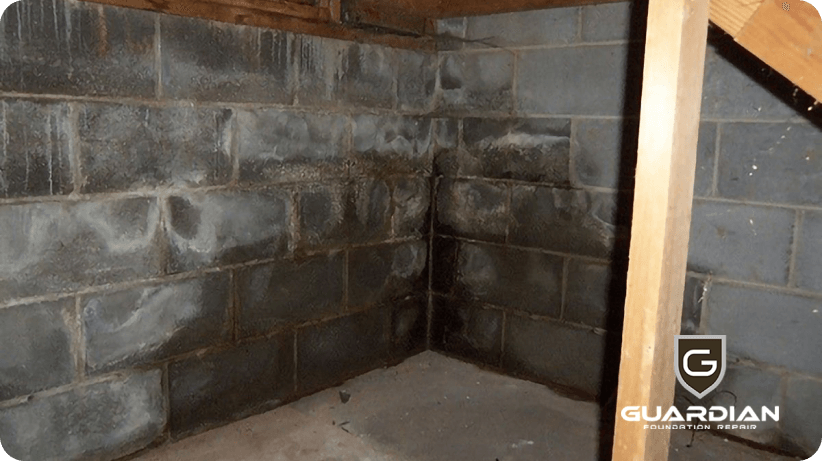Introduction
Discovering cracks or bowed walls in your basement can be worrisome. These problems aren’t just about appearance; they can indicate serious structural issues that need prompt attention. Left unaddressed, they could lead to significant damage or even wall collapse. Fortunately, with the right approach, repairing your basement walls can be manageable.
Whether you’re dealing with small cracks from natural shrinkage or more severe damage from water or foundation problems, this guide will help you navigate the repair process. We’ll cover various methods to keep your home safe and structurally sound. By the end, you’ll know how to handle these problems effectively and prevent them from returning.
Read on to learn how to protect your home with effective basement wall repair methods.
Warning Signs of Basement Wall Damage
Understanding the early warning signs of basement wall issues can help you take prompt action to prevent severe structural damage. Here are some key indicators that your basement walls may require repair:
Tilting or Leaning Walls: When the outer part of the foundation settles deeper into the soil while the inner part remains stable, your walls can tilt or lean. This uneven movement can compromise the structural integrity of your basement.
Gaps between Ceiling and Walls: If you notice gaps or separations where the ceiling meets the walls, it may indicate that the foundation is shifting. This can cause different parts of your home to move independently, leading to visible separations.
Step-Like Cracks: Cracks appearing in a stair-step pattern on concrete block walls or brick facades suggest the foundation is settling unevenly. These cracks typically follow the mortar joints and indicate significant structural movement.
Difficulties with Doors and Windows: If doors and windows become hard to open or close, it could be due to misaligned frames caused by foundation settling. This pressure distorts the frames, making them stick or become uneven.
Chimney Movement: A chimney pulling away from the house or showing signs of cracking or leaning suggests that the foundation beneath it is shifting. This can be a severe issue, indicating broader foundational problems.
Uneven Flooring: Uneven floors might not always be evident. Still, if you feel tripping or notice a slope as you walk across a room, it could be due to the foundation settling, affecting the floor’s level.
Visible cracks in walls and ceilings cracks in the walls or ceilings are a common sign of foundation problems. Small cracks under 1/10 of an inch may be due to normal settling, but larger cracks indicate more serious structural issues that must be addressed.
Are All Basement Wall Cracks A Cause To Worry?
Not all basement wall cracks indicate serious structural problems. Some are purely cosmetic and do not threaten your home’s integrity. Here’s how to differentiate between non-structural and structural cracks:
Non-Structural Cracks:
Non-structural cracks are typically small and result from the natural curing process of concrete. As the concrete cures, it shrinks slightly, leading to hairline cracks in the foundation walls. These cracks are usually thin and do not expand over time.
Identifying Non-Structural Cracks
- Appearance: Hairline width is limited to one or two blocks in cinder block walls.
- Behavior: They remain stable over time without growing or widening.
- Common Causes: Shrinkage during the concrete curing process.
Potential Concerns:
While non-structural cracks are generally not significant, they can allow water to seep through, especially if there is high hydrostatic pressure in the surrounding soil. This can lead to dampness or minor leaks in your basement, which should be addressed to prevent mold and mildew.
Structural Cracks:
Structural cracks are more severe and can affect the foundation’s integrity. These cracks often result from external pressures such as hydrostatic pressure, improper construction, expansive soils, frost heave, or heavy loads near the foundation.
Identifying Structural Cracks
- Appearance: Wider than hairline cracks, often in horizontal, vertical, or stair-step patterns. Diagonal cracks can also indicate significant issues.
- Behavior: They grow over time, becoming broader and more pronounced.
- Common Causes: Hydrostatic pressure, foundation settlement, frost heave, or external loads.
Potential Concerns:
Structural cracks can compromise the stability of your home. If left unaddressed, they can lead to severe issues like wall collapse, significant property devaluation, and safety hazards. Timely intervention is crucial to prevent these problems.
Understanding the type and severity of basement wall cracks is essential for deciding on the appropriate action. If you’re unsure about the cracks’ nature, consult a professional who can evaluate the situation and recommend the best repair method.
What Causes Damage to Basement Walls
Before we dive into the solutions, it’s crucial to understand what leads to damaged basement walls. These issues often arise due to a combination of factors, including:
- Differential Settlement: Differential settlement occurs when different foundation parts settle at different rates into the ground. This can happen due to soil erosion, inadequate construction techniques, or varying soil conditions beneath the foundation. As a result, basement walls may bow, lean, or crack, leading to structural instability.
- Hydrostatic Pressure: Hydrostatic pressure builds up when water accumulates in the soil surrounding your basement. This pressure pushes against the walls, causing them to crack or bow inward. Poor drainage systems and inadequate waterproofing exacerbate this problem, leading to significant damage over time.
- Expansive Soil: Expansive soils change volume with moisture content. When the soil around your foundation absorbs water, it expands, and when it dries out, it contracts. This constant expansion and contraction can exert immense pressure on basement walls, leading to cracks and structural damage.
- Frost Heave: Frost heave occurs when the soil beneath your foundation freezes and expands. This upward movement can lift and crack basement walls. When the soil thaws, it settles back down, causing additional stress and potential damage to the foundation.
- Poor Construction Techniques: Substandard materials or improper construction methods can weaken the structural integrity of basement walls. These include inadequate reinforcement, insufficient concrete curing, and improper material mixing, all of which can lead to premature wall failure.
- Heavy Loads: Placing heavy objects or structures near the foundation, such as large vehicles, home additions, or extensive landscaping features, can put additional stress on basement walls. This added pressure can cause walls to crack or bow, especially if the foundation is not designed to handle such loads.
- Unstable Soil: The soil composition around your foundation can impact wall stability. Different soil types can exert varying amounts of pressure on your basement walls. Soils that are too loose or too dense can cause shifts and instability, affecting the foundation.
- Water Accumulation: Excess moisture in the soil can exert additional pressure on basement walls, leading to cracks and bowing. This is particularly problematic in areas with poor drainage or high water tables.
Concerned about the state of your basement walls?
Guardian Foundation Repair offers expert basement wall repair methods to ensure your home’s stability.
3 Effective Basement Wall Repair Methods Used by Foundation Repair Experts
Choosing the proper method to repair basement walls depends on the extent of the damage. More severe issues often require more expensive and time-consuming solutions.
Early intervention is crucial to prevent further deterioration. It’s important to note that fixing a bowed basement wall doesn’t always mean restoring it to its original position. The main goal is to stabilize the wall to prevent additional damage. Consulting a qualified house foundation repair specialist is essential for assessing the damage and applying the appropriate solution.
Here are three effective basement wall repair methods used by foundation experts at Guardian Foundation Repair to secure your home structure:
I-Beam Installation
Steel I-beams reinforce basement walls that have bowed or have over an inch of displacement. These vertical steel reinforcement beams redistribute the weight and pressure evenly across the wall, preventing potential damage from soil erosion, water seepage, hydrostatic pressure, frost heave, or natural disasters like earthquakes.
Benefits of I-Beam Installation:
- Minimal disruption to your basement space
- Resistant to corrosion
- Durable and lightweight
- Quick to install
- Provides high-strength reinforcement
- Economical solution
I-Beam Installation Process:
- Assessment: Conduct a thorough inspection to determine the extent of the bowing and suitability for I-beam installation.
- Preparation: Measure the distance between the basement floor and ceiling to ensure proper beam length. Clear the installation area and prepare the wall surface.
- Installation: Anchor W6x16 I-Beams to the floor systems above and below with 1/2-inch bolts. Position the beams vertically along the bowed wall, typically at 4 to 6-foot intervals.
- Securing: Fill gaps between the wall and the I-beam with high-strength mortar to reduce movement. Wood blocking is sometimes added to the floor system above to prevent twisting and movement.
- Finishing: Ensure beams are securely placed, then paint or cover them to match the basement décor.
Carbon Fiber Installation
Carbon Fiber Installation is ideal for reinforcing basement walls with vertical or horizontal cracks caused by hydrostatic pressure, often due to poor drainage, such as overflowing gutters or clogged downspouts. These bands help stabilize walls by distributing pressure and preventing further bowing.
Benefits of Carbon Fiber Installation:
- Easily concealed with standard framing
- Minimal disruption to your yard and home
- Quick and efficient installation
- Resistant to corrosion and environmental damage
- Strong reinforcement suitable for various wall types
Carbon Fiber Installation Process:
- Assessment: Conduct a thorough inspection of the wall to determine the extent of the cracking and suitability for carbon fiber installation.
- Preparation: Clean and prepare the wall surface for installation.
- Vertical Cracking: Install horizontal carbon fiber bands centered over the vertical crack, starting 2 feet from the bottom and placed on 2-foot centers.
- Horizontal Cracking: Install vertical carbon fiber systems, including a 4-inch kevlar-reinforced carbon fiber band with anchors at the top and bottom to securely fasten to the slab below and the floor system above.
- Securing: Ensure the bands are securely in place and fill gaps with appropriate materials to provide additional stability.
- Assessment: Once the installation is complete, a final evaluation will be conducted to ensure everything has been installed to engineering specifications.
Tie-Back Wall Anchors
When basement walls bow more than two inches, stabilizing them with steel tie-back wall anchors in Knoxville becomes essential. These anchors connect the interior basement wall to a secure soil anchor outside, providing necessary support. This method involves more labor and time than carbon fiber straps, requiring work both inside and outside the basement, including some excavation around the affected wall.
Benefits of Tie-Back Wall Anchors:
- Strong and durable
- Cost-effective
- Corrosion-resistant
- Minimal disruption
- Long-term stability
- Does not interfere with the basement space
- Adjustable for ongoing support
- Low-profile plates that can be easily finished
- Customizable for different foundation types
Tie-Back Wall Anchors Installation Process:
- Assessment: Inspect the wall to evaluate the degree of bowing.
- Excavation: Dig around the wall to position the anchors.
- Anchor Installation: Drive steel rods into the soil behind the wall until they reach stable ground.
- Securing Anchors: Attach the rods to steel plates or C-channels inside the basement.
- Reinforcement: Install anchors at 4 to 6-foot intervals, filling the wall with concrete if necessary.
- Adjustments: Gradually tighten the rods to stabilize the wall.
Secure Your Basement from Damage with Basement Wall Repair Services
Addressing basement wall issues promptly can prevent higher costs and severe damage. Delaying repairs can lead to substantial expenses, extensive damage, and potential safety risks.
Guardian Foundation Repair is your trusted partner if you’re in the Knoxville area and need reliable basement wall repair. We offer comprehensive services, including basement waterproofing, crawl space encapsulation, crawl space repair, and foundation repair.
Contact us today for an in-depth inspection, a free repair estimate, and a range of practical solutions to protect your home.


